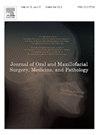Clinical evaluation of greater palatine artery hemodynamics in Le Fort I osteotomy
IF 0.4
Q4 DENTISTRY, ORAL SURGERY & MEDICINE
Journal of Oral and Maxillofacial Surgery Medicine and Pathology
Pub Date : 2024-10-13
DOI:10.1016/j.ajoms.2024.10.002
引用次数: 0
Abstract
Objective
Le Fort I osteotomy (LIO) is a widely known standard orthognathic surgical treatment. However, complications such as osteonecrosis of the jaw due to poor postoperative blood flow to tissues of the maxilla have been reported. This study measured the hemodynamics of the greater palatine artery (GPA) in patients who underwent LIO to explore the factors that affect postoperative blood flow.
Methods
We included 15 patients who underwent LIO and sagittal split ramus osteotomy (SSRO), and 8 patients, who only underwent SSRO, were included as controls. Preoperative, intraoperative, and postoperative blood flow in the oral mucosa anterior to the foramen magnum was measured with a laser Doppler blood flow meter.
Results
On average blood flow at immediately after downfracture in LIO patients reduced to 24.8 % of baseline blood flow and patients who underwent anterior maxillary movement had a lower recovery rate at any time. Multiple regression analysis showed that the greater the maxillary anterior shift and the longer the time from maxillary disarticulation to fixation (mandibular fracture time: DFT), the more delayed was the blood flow recovery.
Conclusions
Since blood flow decreased after downfracture and recovered only to around 85.4 % of baseline after 6 months in LⅠO, preserving blood vessels is important. Furthermore, the recovery rate was lower in patients who underwent anterior movement, and blood flow reduced more in patients with longer DFT, suggesting the importance of determining the direction and distance of movement preoperatively, and repositioning and fixing the maxilla as quickly as possible during surgery.
求助全文
约1分钟内获得全文
求助全文
来源期刊

Journal of Oral and Maxillofacial Surgery Medicine and Pathology
DENTISTRY, ORAL SURGERY & MEDICINE-
CiteScore
0.80
自引率
0.00%
发文量
129
审稿时长
83 days
 求助内容:
求助内容: 应助结果提醒方式:
应助结果提醒方式:


